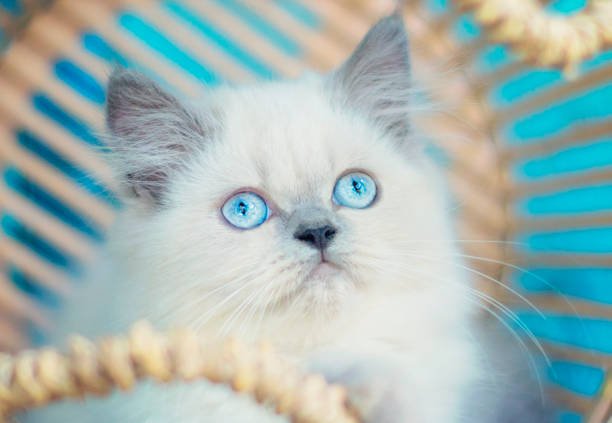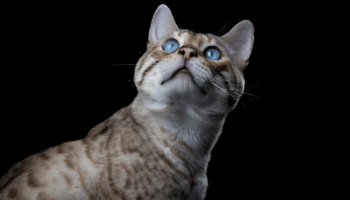Adopt a Blue Seal Point Himalayan Kitten Today: Expert Tips Inside
Blue seal point Himalayan kittens are a special type of cat that many people find absolutely charming. With their striking looks and sweet personalities, these kittens have become a favorite among cat lovers. In this article, we’ll explore what makes these kittens so unique, their distinct characteristics, and how they differ from other Himalayan cats.

What is a Blue Seal Point Himalayan Kitten?
The Evolution of Himalayan Cats
The Himalayan cat breed has a fascinating history that combines the best traits of Persian and Siamese cats. This breed was developed in the 1930s when breeders aimed to create a cat with the luxurious coat of a Persian and the striking color points of a Siamese. The result was a beautiful cat with a long, silky coat and distinctive point coloration on the ears, face, paws, and tail. Blue seal points are one of the many color variations within this breed, known for their unique bluish-gray points. Over the years, the Himalayan has become a popular breed for its beauty and gentle personality.
Unique Characteristics and Appearance
Blue seal point Himalayan kittens are known for their distinct features and stunning looks. They have a few standout characteristics that make them easy to recognize:
Beautiful Color Pattern: Their dark brown and bluish-gray “points” contrast with their lighter, cream-colored body. This gives them a striking and elegant appearance.
Bright Blue Eyes: One of the most captivating features of blue seal point Himalayans is their bright blue eyes. These vivid eyes add to their overall charm and beauty.
Fluffy Coat: These kittens have a long, soft, and fluffy coat inherited from their Persian ancestors. Their fur is silky and requires regular grooming to keep it looking its best.
Compact Build: Blue seal point Himalayans have a sturdy, compact build with a round face and small, flat nose. This gives them a cute and distinctive appearance.
How They Differ from Other Himalayan Cats
Blue seal point Himalayan cats stand out from their Himalayan cousins with their unique bluish-gray points on their ears, faces, paws, and tails, contrasted against a lighter body color. This gives them a distinct and striking appearance. In terms of personality, blue seal points are known for being particularly affectionate and gentle. They love cuddling and being close to their human companions, making them especially loving pets. Their combination of unique looks and sweet temperament sets them apart from other Himalayan cats.
Caring for Your Blue Seal Point Himalayan Kittens
Diet and Nutrition Tips
Feeding your blue seal point Himalayan kitten the right diet is crucial for its health and growth. These kittens thrive on high-quality cat food that provides the necessary nutrients. Look for food that lists meat as the first ingredient and avoid fillers like corn and soy.
Kittens need more protein and fat than adult cats, so choose a food specifically formulated for kittens. Wet food can be a good choice as it provides hydration and can be more palatable. Always ensure fresh water is available.
If you’re unsure about the best diet for your kitten, consult your veterinarian. They can recommend the right food and feeding schedule based on your kitten’s needs.
Grooming Requirements for Long-Haired Cats
Blue seal point Himalayan kittens have long, luxurious fur that requires regular grooming to prevent mats and tangles. Brush your kitten daily using a gentle brush designed for long-haired cats. This not only keeps their coat smooth but also reduces shedding and hairballs.
Bathing your kitten occasionally can help keep their coat clean, but it’s not always necessary if you brush them regularly. Use a gentle cat shampoo and rinse well to ensure no residue is left behind.
Regularly check and clean their ears, trim their nails, and brush their teeth to keep them healthy. Starting these routines while your kitten is young will make them easier to manage as they grow.
Health Concerns to Watch Out For
Like all breeds, blue seal point Himalayan kittens can be prone to certain health issues. Some common concerns include respiratory problems due to their flat faces, dental issues, and polycystic kidney disease (PKD).
Keep an eye on your kitten for any signs of breathing difficulties, coughing, or excessive sneezing. Regular vet check-ups are essential to catch any health issues early. Your vet can also provide guidance on preventing and managing any potential health problems.
Best Practices for Socializing Your Kitten
Socializing your blue seal point Himalayan kitten is important to ensure it grows into a well-adjusted adult cat. Start by introducing your kitten to different environments, people, and other pets gradually and positively.
Spend time playing with your kitten using toys to encourage interaction and mental stimulation. Encourage gentle handling by giving treats and praise. Expose your kitten to various sounds and experiences to build their confidence. Proper socialization helps your kitten feel secure and can reduce the risk of behavioral issues later on.
Common Misconceptions
Blue seal point Himalayan kittens are often surrounded by myths and misconceptions. Let’s clear up some of these misunderstandings and get to the truth about these beautiful cats.
Myth: Blue Seal Points are High Maintenance
Many people think that blue seal point Himalayan kittens are hard to take care of. This isn’t true! While they do need some attention, they are not overly demanding.
Grooming: Yes, they have long, fluffy fur that requires regular grooming to prevent mats and tangles. Brushing them a few times a week is usually enough to keep their coat in good shape. This can also be a fun bonding time with your kitten.
Living Space: Blue seal point Himalayans are quite adaptable. They don’t need a huge space to be happy. As long as they have a cozy spot to sleep, some toys to play with, and a scratching post, they’ll be content.
Personality: These kittens are known for being laid-back and loving. They enjoy spending time with their owners but are also perfectly happy lounging around on their own. They don’t need constant attention, making them a great choice for people with busy lifestyles.
Myth: They Have Health Issues Due to Their Breed
Another common myth is that blue seal point Himalayan kittens have a lot of health problems because of their breed. While it’s true that all breeds can have some health issues, blue seal point Himalayas are generally healthy if properly cared for.
Regular Vet Checkups: Like any other pet, they benefit from regular visits to the vet.This helps identify potential problems early. With good care, these kittens can live long, healthy lives.
Breathing Issues: Some people worry about breathing problems because of their flat faces. While it’s true they might have shorter noses, not all blue seal point Himalayans experience breathing issues. Choosing a kitten from a reputable breeder who focuses on healthy breeding practices can reduce this risk.
General Health: Keeping them at a healthy weight, feeding them a balanced diet, and providing a clean, stress-free environment can go a long way in preventing health problems.
Debunking Other Common Myths
There are a few more myths about blue seal point Himalayan kittens that we need debunking.
Myth: They are Not Good with Kids: Blue Seal Point Himalayans are actually great with children. Their calm and friendly nature makes them wonderful companions for kids. They are patient and gentle, which is ideal for a household with young ones.
Myth: They are Aloof: Some people think that because they look so regal, they must be aloof or standoffish. In reality, blue seal point Himalayans are very affectionate. They love spending time with their families and are known to be very cuddly and loving.
Myth: They Don’t Play Much: While they might seem like lap cats, blue seal point Himalayans also enjoy playing. They love interactive toys and games that stimulate their minds and bodies. Regular playtime is important for keeping them healthy and happy.
Tips for Selecting a Blue Seal Point Himalayan Kitten
Bringing a blue seal point Himalayan kitten into your home can be a wonderful experience. To ensure you get a healthy and happy kitten, it’s important to choose a reputable breeder and know what to look for. Here are some useful tips to help you through the process.
What to Look for in a Reputable Breeder
Finding a trustworthy breeder is the first step in bringing home a healthy kitten. Here’s what to look for:
Experience and Knowledge: A good breeder should have plenty of experience with Himalayan cats and a deep understanding of the breed. They should be able to answer all your questions about the kittens and their care.
Clean and Caring Environment: Visit the breeder’s facility if you can. The place should be clean and well-maintained. The kittens should look healthy, active, and well-cared for. Pay attention to how the breeder interacts with the cats—this shows how much they care about their well-being.
Health Checks: Reputable breeders will have their kittens checked by a vet and provide you with health records. They should also offer a health guarantee, which means they will take the kitten back if any genetic health issues arise.
Socialization: Good breeders make sure their kittens are well-socialized. The kittens should be used to being handled by people and should show friendly, confident behavior.
Questions to Ask Before Adoption
Before you decide on a kitten, it’s important to ask the breeder some key questions. Here are a few to consider:
Health History: Ask about the health history of the kitten’s parents. This can give you an idea of any potential health issues your kitten might face.
Vaccinations and Deworming: Confirm that the kittens have received their initial vaccinations and deworming treatments. Ask for documentation of these treatments.
Diet and Care: Ask what the kittens have been eating and what kind of care they have been receiving. This helps you continue the same routine when you bring your kitten home.
Return Policy: Find out if the breeder has a return policy. This is important in case you discover any health issues or if, for some reason, you cannot keep the kitten.
Spaying/Neutering: Some breeders will have the kittens spayed or neutered before adoption. If not, ask when you should plan to have this done.
Red Flags to Avoid
While searching for a kitten, be aware of some warning signs that might indicate an unreliable breeder:
No Health Records: If the breeder cannot provide health records or a vet check-up history for the kittens, this is a big red flag. Reputable breeders always keep track of their animals’ health.
Unwillingness to Show the Facility: If the breeder is reluctant to let you see where the kittens are kept, this might indicate poor living conditions or unhealthy animals.
Pushy Sales Tactics: Be wary of breeders who seem more interested in making a quick sale than ensuring their kittens go to good homes. A good breeder will ask you questions too, to make sure you’re a suitable pet owner.
Too Many Breeds: Breeders who are selling multiple breeds might be more interested in profit than the health and well-being of their animals. Specializing in one or two breeds is a better sign of quality care.
Young Kittens: Kittens should not be separated from their mothers too early. They should be at least 8-12 weeks old before going to a new home. If a breeder tries to sell you a very young kitten, this is a red flag.
Practical How-To Guides for Blue Seal Point Himalayan Kitten Owners
Step-by-Step Guide to Kitten-Proofing Your Home
Ensure your home is safe for your new furry friend. Start by removing any small objects that a curious kitten might swallow. Keep electrical cords out of reach or cover them to prevent chewing. Secure any toxic plants or household chemicals in places where your kitten can’t get to them. Make sure windows and balconies are secure to prevent accidents. Creating a safe space helps your kitten explore and play without danger.
How to Create a Comfortable Living Environment
To make your blue seal point Himalayan kitten feel at home, set up a cozy living space. Provide a warm bed in a quiet corner where your kitten can rest. Have plenty of toys to keep your kitten entertained and stimulated. A scratching post is essential to keep their claws healthy and away from your furniture. Make sure they have easy access to food, water, and a clean litter box. By creating a comfortable and inviting environment, you’ll help your kitten feel secure and happy.
Training Your Kitten: Tips and Techniques
Training your blue seal point Himalayan kitten can be simple and fun. Start with basic commands like “sit” and “come,” using treats and praise to reward good behavior.Keep your training sessions consistent, short, and positive. Use a scratching post to teach your kitten where it’s okay to scratch, and gently redirect them if they use your furniture instead. Litter box training is usually easy, as kittens naturally want to use a clean, designated spot. With patience and positive reinforcement, your kitten will quickly learn good habits and become a well-behaved cat.
Insider Insights and Expert Analysis
Current Research on Himalayan Cat Genetics
Research on Himalayan cat genetics continues to provide insights into their unique characteristics. Scientists study the genetic markers that determine their color points and long fur. These studies help breeders understand how to produce healthy kittens with desired traits. Recent research has also focused on the genetic basis of certain health issues common in flat-faced breeds, aiming to improve the overall health and well-being of Himalayan cats. By understanding the genetics behind these cats, breeders can make informed decisions to ensure the breed remains healthy and vibrant.
Expert Predictions for the Future of the Breed
Experts in the field of cat breeding and genetics have optimistic predictions for the future of the Himalayan breed. They foresee continued popularity for these cats due to their striking appearance and friendly nature. Breeders are expected to focus more on health, aiming to reduce the prevalence of genetic health issues through careful selection and breeding practices. There is also likely to be an emphasis on maintaining the breed’s distinctive features while ensuring a high quality of life for the cats. Blue seal point Himalayans, with their unique color and gentle disposition, will remain a cherished variation within the breed.
Final Thoughts
Blue seal point Himalayan kittens are a beautiful and affectionate breed with unique blue-gray points and striking blue eyes. We've covered their genetics, debunked myths about their maintenance and health, and offered tips for selecting a reputable breeder, preparing your home, and training your kitten. We also discussed the breed's history, current research, and ways to connect with other owners. If you're ready to bring a blue seal point Himalayan kitten into your life, take action this week by researching breeders, joining online communities, or visiting a cat show. Start your journey with these delightful kittens today!













